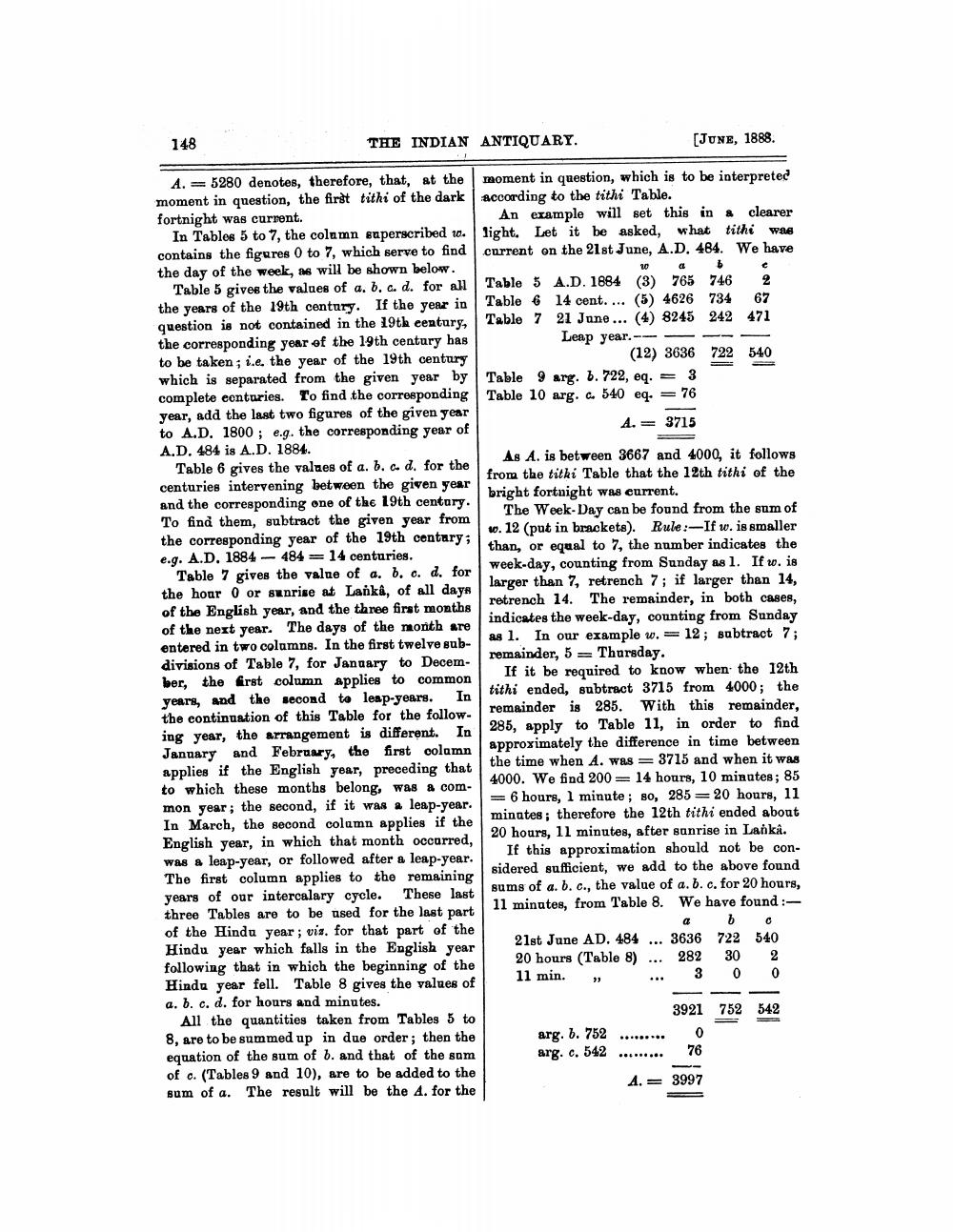________________
148
A. 5280 denotes, therefore, that, at the moment in question, the first tithi of the dark fortnight was current.
In Tables 5 to 7, the column superscribed w. contains the figures 0 to 7, which serve to find the day of the week, as will be shown below.
THE INDIAN ANTIQUARY.
Table 5 gives the values of a. b. c. d. for all the years of the 19th century. If the year in question is not contained in the 19th century, the corresponding year of the 19th century has to be taken; i.e. the year of the 19th century which is separated from the given year by complete centuries. To find the corresponding year, add the last two figures of the given year to A.D. 1800; e.g. the corresponding year of A.D. 484 is A.D. 1884.
Table 6 gives the values of a. b. c. d. for the centuries intervening between the given year and the corresponding one of the 19th century. To find them, subtract the given year from the corresponding year of the 19th century; e.g. A.D. 1884-484 14 centuries.
Table 7 gives the value of a. b. c. d. for the hour 0 or sunrise at Lanka, of all days of the English year, and the three first months of the next year. The days of the month are entered in two columns. In the first twelve sub
divisions of Table 7, for January to December, the first column applies to common In years, and the second to leap-years. the continuation of this Table for the following year, the arrangement is different. In January and February, the first column applies if the English year, preceding that to which these months belong, was a common year; the second, if it was a leap-year In March, the second column applies if the English year, in which that month occurred, was a leap-year, or followed after a leap-year. The first column applies to the remaining These last years of our intercalary cycle. three Tables are to be used for the last part of the Hindu year; viz. for that part of the Hindu year which falls in the English year following that in which the beginning of the Hindu year fell. Table 8 gives the values of a. b. c. d. for hours and minutes.
[JUNE, 1888. moment in question, which is to be interpreted according to the tithi Table.
An example will set this in a clearer light. Let it be asked, what tithi was current on the 21st June, A.D. 484. We have
All the quantities taken from Tables 5 to 8, are to be summed up in due order; then the equation of the sum of b. and that of the sam of c. (Tables 9 and 10), are to be added to the sum of a. The result will be the A. for the
Table 5 Table 6 Table 7
w
a
b
c
A.D. 1884 (3) 765 746 2 67 14 cent.... (5) 4626 21 June... (4) 8245 Leap year.
734 242 471
(12) 3636 722 540 Table 9 arg. b. 722, eq. = Table 10 arg. c. 540 eq.
3 76
=
A. 3715
As A. is between 3667 and 4000, it follows from the titki Table that the 12th tithi of the bright fortnight was current.
The Week-Day can be found from the sum of w. 12 (put in brackets). Rule:-If w. is smaller than, or equal to 7, the number indicates the week-day, counting from Sunday as 1. If w. is larger than 7, retrench 7; if larger than 14, retrench 14. The remainder, in both cases, indicates the week-day, counting from Sunday as 1. In our example w. 12; subtract 7; remainder, 5 = Thursday.
If it be required to know when the 12th tithi ended, subtract 3715 from 4000; the remainder is 285. With this remainder, 285, apply to Table 11, in order to find approximately the difference in time between the time when A. was = 3715 and when it was 4000. We find 200 14 hours, 10 minutes; 85
6 hours, 1 minute; so, 28520 hours, 11
minutes; therefore the 12th tithi ended about 20 hours, 11 minutes, after sunrise in Lanka.
If this approximation should not be considered sufficient, we add to the above found
sums of a. b. c., the value of a. b. c. for 20 hours, 11 minutes, from Table 8. We have found :a b c 3636 722 540 282 30 2 3 0 0 3921 752 542 0 76
21st June AD. 484 20 hours (Table 8) 11 min.
arg. b. 752 arg. c. 542
...
*******.
A. 3997
=




